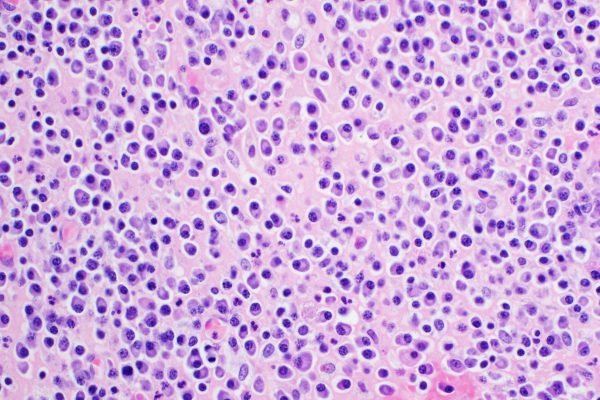
The phase II RedirecTT-1 trial demonstrated deep and durable responses with the combination of talquetamab and teclistamab in patients with triple-class exposed relapsed/refractory multiple myeloma (R/R MM) and extramedullary disease (EMD). This dual-targeting approach outperformed standard and other novel T-cell redirecting therapies. Combining the agents did not exacerbate adverse events compared to monotherapy, although the infection profile highlights the need for vigilant monitoring and proactive management.
EMD is associated with poor outcomes in multiple myeloma. A recent meta-regression of nine clinical trials showed that patients with EMD are 87% less likely to respond to therapy compared to those without EMD.1 Another study confirmed low response rates in heavily pretreated, triple-class exposed R/R MM patients with EMD.2 Both talquetamab and teclistamab are first-in-class bispecific antibodies approved as monotherapies for triple-class exposed R/R MM. Results from the phase I RedirecTT-1 EMD cohort already suggested promising activity with the combination.3,4 At EHA 2025, efficacy and safety results of the phase II RedirecTT-1 EMD cohort were presented.5
Study design
The phase II RedirecTT-1 trial enrolled patients with triple-class exposed R/R MM and EMD, defined as ≥1 non-radiated bone-independent soft tissue plasmacytoma ≥2 cm in greatest dimension, confirmed by central review of PET-CT scans. Patients with non-secretory or oligosecretory disease were eligible. Prior CAR T-cell therapy and non-BCMA/non-GPRC5D bispecific antibody therapy were permitted. Treatment consisted of talquetamab 0.8 mg/kg every two weeks combined with teclistamab 3.0 mg/kg every two weeks following three step-up doses. Therapy was continued until disease progression. At the investigator’s discretion, patients could switch to monthly dosing after cycle 6, or after cycle 4 if a very good partial response or better (≥VGPR) had been achieved. The primary endpoint was objective response rate (ORR) assessed by central radiology review of whole-body PET-CT scans.
Results
A total of 90 patients were enrolled. Median age was 64.5 years. High-risk cytogenetics were present in 21.5% of patients, and 38.8% had non-secretory or oligosecretory disease. The median number of extramedullary plasmacytomas per patient was two (range: 1-7). Twenty percent of patients had received prior anti-BCMA CAR-T cell therapy, and 8.9% had previously been treated with bispecific antibodies.
At a median follow-up of 12.6 months, the ORR was 78.9%, with a complete response or better (≥CR) achieved in 54.4% of patients and ≥VGPR in 70.0%. The median time to first response was 2.6 months, while the median time to best response was 4.7 months. Among the 71 responders, 77.5% switched to monthly dosing, most commonly after cycles 4-6. In the majority of cases (92.7%), responses deepened or were maintained after switching. The median duration of response was 13.8 months. At one year, the estimated rate of freedom from progression was 64%. Median progression-free survival (PFS) was 15.4 months, and the estimated one-year PFS rate was 61%. Median overall survival (OS) was not reached, with an estimated one-year OS rate of 75%.
Cytokine release syndrome (CRS) was reported in 77.8% of patients, with all events limited to grade 1 or 2. The majority of CRS events occurred during the step-up dosing phase. Immune effector cell-associated neurotoxicity syndrome (ICANS) was observed in 12.2% of patients, including grade 1 in 5.6%, grade 2 in 4.4%, grade 3 in 1.1%, and grade 4 in 1.1%. Most ICANS events occurred during step-up dosing or within cycle 1. Neutropenia was the most frequent grade 3-4 adverse event (62.2%). Infections occurred in 78.9% of patients, with 31.1% being grade 3-4 and 5.6% being grade 5. Nearly all patients (96.7%) received antiviral prophylaxis. Ten patients had grade 5 adverse events, including 5 infections.
Conclusion
This phase II analysis of the RedirecTT-1 EMD cohort showed that the combination of talquetamab and teclistamab induced deep and durable responses in a population with triple-class exposed R/R MM and EMD. No new safety signals emerged. Infections occurred in the majority of patients, with 31.1% being grade 3-4 and 5.6% being grade 5. These findings highlight the potential clinical benefit of dual-antigen targeting in patients with a high disease burden and significant unmet need.
References
1. Voorhees P, Kumar S, Usmani SZ, et al. Clinical outcomes of patients with relapsed or refractory multiple myeloma with and without extramedullary disease. Presented at EHA 2025; Poster PF768.
2. Moreau P, Mateos MV, Goldschmidt H, et al. Outcomes of patients with extramedullary disease in triple-class exposed relapsed/refractory multiple myeloma from the pooled LocoMMotion and MoMMent studies. Clin Lymphoma Myeloma Leuk 2025;doi:10.1016/j/clml.2025.03.014.
3. Cohen YC, Magen H, Gatt M, et al. Talquetamab + teclistamab in patients with relapsed/refractory multiple myeloma: updated phase 1b results from RedirecTT-1 with >1 year of follow-up. Oral Presentation presented at: 21st International Myeloma Society (IMS) Annual Meeting; September 25-28, 2024; Rio de Janeiro, Brazil.
4. Cohen YC, Magen H, Gatt M, et al. Talquetamab plus teclistamab in relapsed or refractory multiple myeloma. N Engl J Med 2025;392(2):138-49.
5. Kumar S, Mateos MV, Ye JC, et al. Phase 2 study of talquetamab + teclistamab in patients with relapsed/refractory multiple myeloma and extramedullary disease: RedirecTT-1. Presented at EHA 2025; Abstract LB4001.